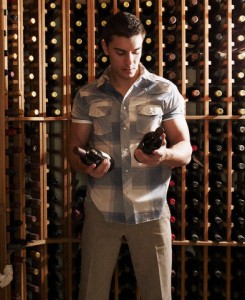 When was the last time you bought a bottle of wine? Did you know what you wanted when you walked into the liquor store or did you just go in and grab a bottle of red because you were having steak for dinner? How do you know if the bottle of vino that you just selected is even any good? What grapes are in that bottle you chose? What about the winery that produced it? Or the region in which these grapes were all harvested? All of these are key elements that you need to think about when considering a bottle of wine.
When was the last time you bought a bottle of wine? Did you know what you wanted when you walked into the liquor store or did you just go in and grab a bottle of red because you were having steak for dinner? How do you know if the bottle of vino that you just selected is even any good? What grapes are in that bottle you chose? What about the winery that produced it? Or the region in which these grapes were all harvested? All of these are key elements that you need to think about when considering a bottle of wine.
So how do you know what to look for in a bottle of wine? If you are like most wine drinkers you are probably selecting based on price. But if you are a connoisseur you will be looking at more detailed information than just red or white. You will be looking for things such as the year the wine was bottled, the grapes that were used to produce that variety, what the cork is made out of, and even what the label looks like. Each of these is crucial when selecting a bottle of wine. Below you will find a list of five things to consider when purchasing your next bottle of wine.
1. Check the label on the bottle.
I know some people who will not buy a bottle of wine before reading every single item on the label. I am one of those people actually. I have this problem with beers as well. I will go to the liquor store, look to buy a bottle of wine or beer, and will always be trying to find something different. It is hard for me to buy the same product twice, even if I like it, as I want to experience one more style of these incredible creations. So, what better way to learn about the wine than to read the label?
The label can tell you all sorts of things. You can learn the year the wine was produced, the flavors you can expect from the wine, the process that the winery used to make the wine, the name and location of the winery, and even awards or reviews that the wine has received. This is a way for the winery to brag about their wine, and based on the number of selections at any given liquor store, their sales pitch as well. So for some wines it might sound like you are reading an awards speech, but that is their attempt to get you to pop that cork.
One way to avoid having to read every single label when purchasing a wine, especially if you do drink the same wine if you have grown to enjoy the flavors packed inside, is by keeping a small notebook with you. If you sit down to taste a wine, or have a bottle for dinner, make some small notes. Note the name of the wine, the winery, the year, and the scents that the nose produces, and the flavors as you experience them. This is a great way to learn not only about the styles of wine that your palette likes but also a way to avoid wines that you may not be a huge fan of on your first try.
2. Smell the wine when possible.
I am sure you have seen people swirling their glass of wine, sticking their nose deep into the glass, and taking a big whiff of the vino before ever tasting it. I do this, as I have a very specific process to enjoying wine, and I am not alone. And there is, in fact, method to this madness. When you take the wine and swirl it in the glass you are oxidizing the wine. You are opening that wine up, for lack of a better term, and allowing the flavors to explore the glass and eventually your palette. Not saying that you should sit there and swirl the glass all day long, but a few good swirls is not a bad idea before you smell the wine.
Now comes one of my favorite parts of the wine drinking process. When you begin to drink wine you will not understand the importance here, but quickly will learn that you can taste just as much by smelling a good wine as you can by actually tasting it. So, after you have finished swirling the wine, place your nose as close to the wine as you can (without actually sticking your nose in the wine itself) and take a big whiff. By smelling a wine you can learn so much about the flavors you are about to experience. I smell my wine twice before ever tasting it and can tell you before I even put the vino in my mouth whether I am going to like it or not.
3. Use your tongue for a balanced taste.
This does not mean just stick your tongue into the glass to taste the wine. This means take a small sip, and make sure you squish the wine around your mouth until it hits every corner of your tongue. Some people will then spit once this process is complete, but you can also swallow if you would like or if there is nowhere to spit. Either way just makes sure that the wine covers your tongue. The reason for this is to make sure that every receptor, every taste bud, is hit. You want to make sure that you are giving your mouth the opportunity to taste the wine for what it is worth, for the reasons behind its creation, and this is the perfect place to test that. Once you have swirled the wine, sniffed the wine, and now swished the wine, you are ready to enjoy it for every ounce of its true flavor.
4. Know the year the wine was bottled.
This might be one of the single most important parts of a wine. By reading those four numbers, you can tell a lot about a wine based on the region, the weather, and the amount of that wine that was produced during that year. So, let’s say you are about to enjoy a bottle of 2007 Pinot Noir. The wine is from Oregon. That might not tell the average wine drinker much, but you can use that and research that year and that variety. You will come to find that 2007, especially for Oregon and northern California wineries, was a very successful year. Oregon alone produced incredible Pinot Noirs based on their rise and fall in temperature, but 2007 was an uncommonly great year for all wines. So, you know that Pinots are good in Oregon and that 2007 was a good year. You can take that and use that in selecting your next wine.
Another thing to note with the date is the price point on that particular bottle. For example, if a winery has a really good year, and chooses to produce only a few hundred cases of any one variety that year, the price will change. The price for a Merlot bottled in 2003 (a great year for Merlot) will be drastically different than a bottle that was corked in 2006. Now, you might be able to find a delicious 2006 Merlot, but for the true wine drinkers out there you will be able to tell a big difference in the taste between those two years. So if you see a wine that looks ordinary, but has a high price tag, note that it was probably made in a good year.
5. Drink the wines that you like.
This is hard for me to talk about since I rarely buy the same bottle twice. Granted, there are times where I have bought the same wine for convenience sake, but I try to avoid it whenever possible. But, for the common wine drinker out there, if you come across a bottle that you like, let’s say a Yellow Tail Shiraz (actually a really good value) there is nothing wrong with sticking to that wine. This is a good idea, especially if you are trying to find something to pair with dinner. You can save a lot of time and a lot of money just by sticking to what you know will work.
If you are carrying around that note pad to take notes on different wines that you sample, this is another good thing to write down. When you took that first sip of Yellow Tail Shiraz, realized that it was less than $10, and you knew it was easy to find (any liquor store, grocery store, or any gas station that carries wine) it can be treated as a “go-to” wine. Do not be afraid to use this wine as a gift as well. If someone invites you over to dinner and you are rushing out the door to make the reservation, swing by Marsh Supermarket and grab a bottle of this. The thought is always what counts here, but this time it is matched with a good wine.
So remember all of this the next time you purchase a bottle of wine. Take the wine, study the label, pop the cork, swirl the glass, sniff a few times, and cover your tongue, spit/swallow, and taste. It might seem like a lot of work to just have a glass of wine, but it is so much more than a beverage. There is passion put into each bottle. Ask any wine maker and they will tell you. It not a matter of simply drinking the wine, but rather appreciating the wine. Bottoms up all of my fellow winos.




Great tips!
I was once a lover of great wines. I worked in the restaurant industry and would often go to wine seminars and tastings.
Recently I’ve had a less adventurous pallet, but every now and then I still like to hold an impromptu wine tasting with friends.
When I do this, I really like to do a little research online prior to visiting the liquor store.
There are so many wine blogs out there that give really good suggestions, especially if you’re on a budget.
Nice tips on selecting a bottle of wine! It’s helpful to know what to look for.
What’s your go-to wine for a casual dinner?